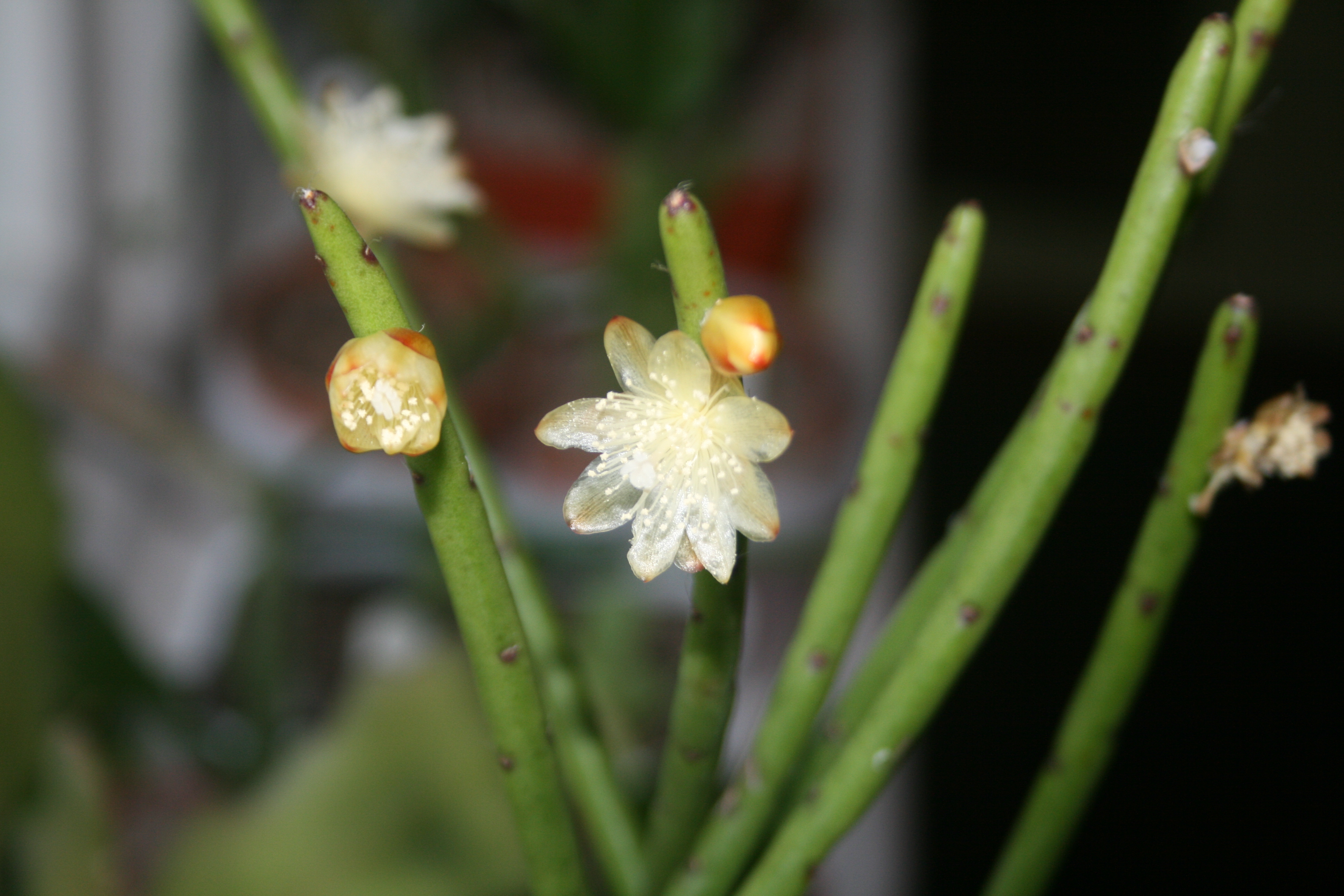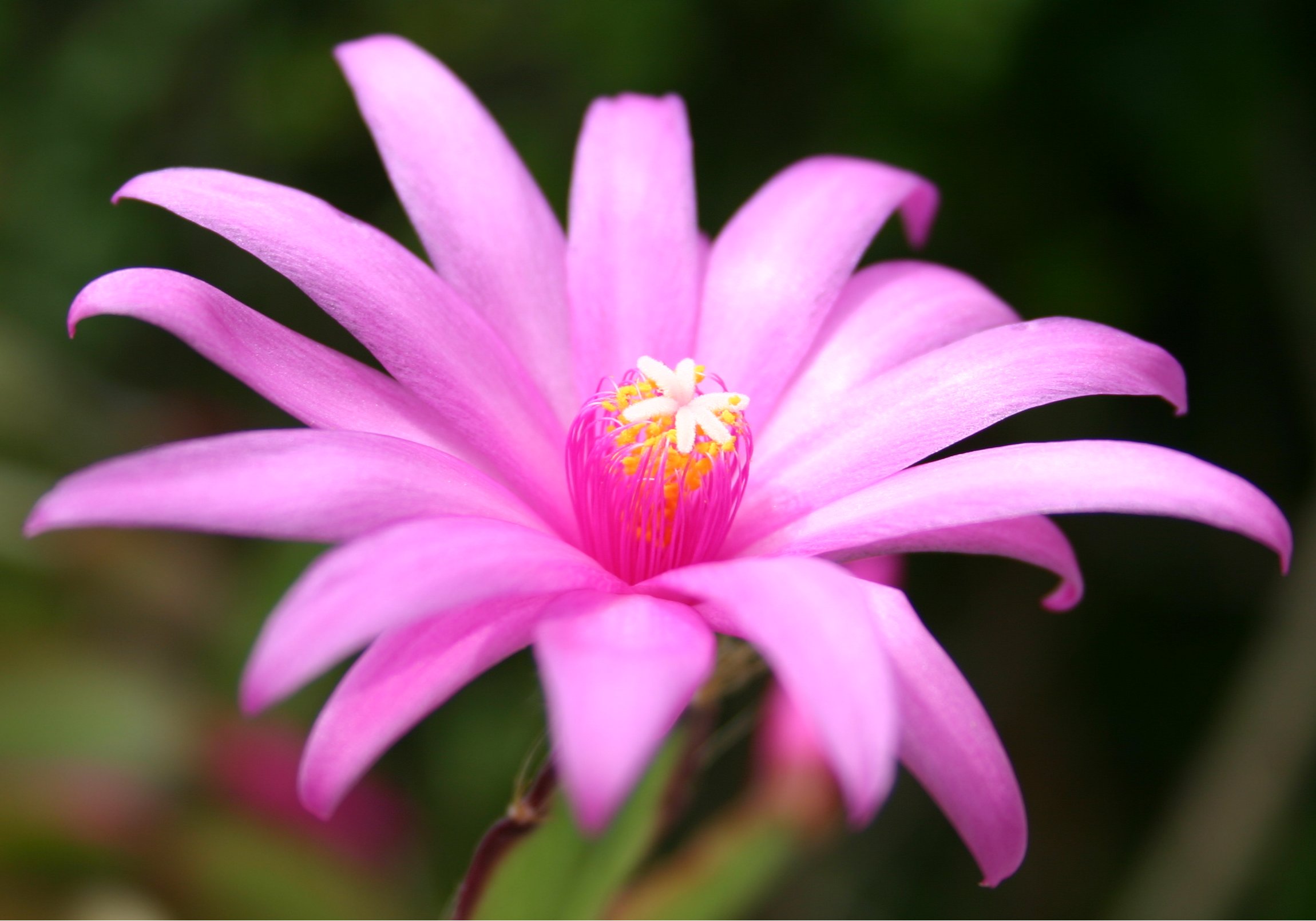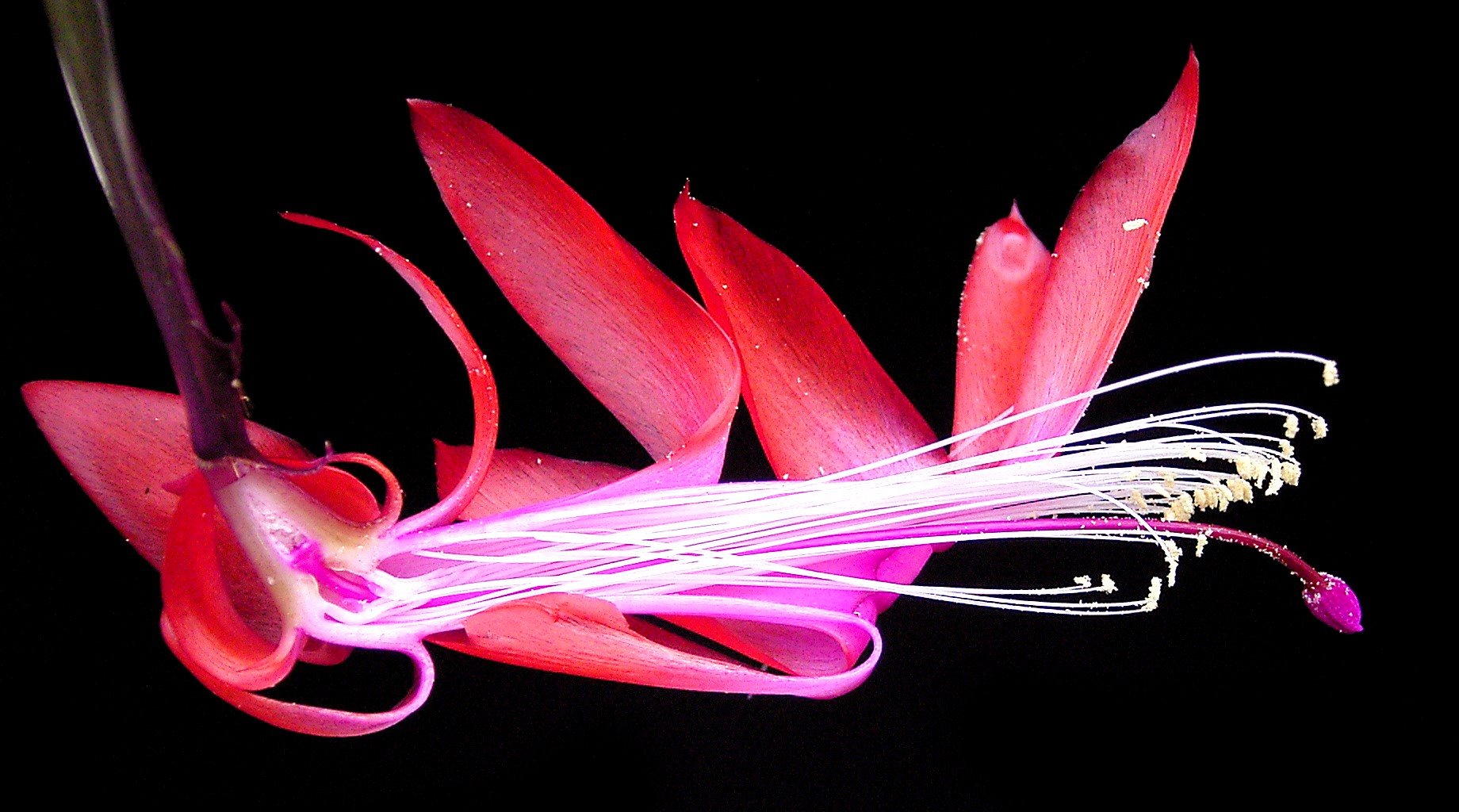|
Rhipsalideae
The Rhipsalideae are a small tribe of cacti, comprising four genera (and around 60 species). They grow on trees (epiphytes) or on rocks (lithophytes), where they either hang down or form creeping or upright shrubs. Their flowers open in the day and remain open at night; they may be either radially symmetrical (regular) or bilaterally symmetrical (zygomorphic). The fruits are berry-like, fleshy with smallish seeds. They are found mainly in the east of South America, with a centre of diversity in Bolivia, but some species occur in Central America and North America; one species, ''Rhipsalis baccifera'', also occurs in the Old World. Taxonomy Cacti belonging to the Rhipsalidae are quite distinct in appearance and habit from other cacti, growing on trees or rocks as epiphytes or lithophytes, and are thus easily distinguished. However, for many years there has been confusion as to how to divide the tribe into genera. For example, in 1858 Charles Lemaire recognized the distinctiveness ... [...More Info...] [...Related Items...] OR: [Wikipedia] [Google] [Baidu] |
Hatiora Salicornioides
''Hatiora salicornioides'', the bottle cactus, dancing-bones, drunkard's-dream, or spice cactus, is a species of flowering plant in the cactus family. A member of the tribe Rhipsalideae, it often grows as an epiphyte. It is native to eastern Brazil. It is sometimes grown both indoors and outdoors as an ornamental. Description ''Hatiora salicornioides'' grows to about tall with an erect to pendent growth habit. Its stems are composed of segments long. Each segment is shaped like a club or bottle, with the narrower end at the base. The stems branch from the end of a segment, with up to six branches forming a whorl. The yellow to orange flowers are borne at the ends of younger stem segments, and are long and about the same across when open. Translucent white berries follow the flowers. Hatiora salicomioides - JBM.jpg, Growth habit in cultivation Hatiora salicornioides ies2.jpg, Branching Taxonomy The species was first described by Adrian H. Haworth in 1819, as ''Rhipsalis sa ... [...More Info...] [...Related Items...] OR: [Wikipedia] [Google] [Baidu] |
Hatiora
''Hatiora'' is a small genus of epiphytic cacti which belongs to the tribe Rhipsalideae within the subfamily Cactoideae of the Cactaceae. Recent taxonomic studies have led to the three species formerly placed in subgenus ''Rhipsalidopsis'' being removed from the genus, including the well known and widely cultivated ornamental plants known as Easter cactus or Whitsun cactus (cultivars or hybrids of the former '' Hatiora gaertneri''). Description All ''Hatiora'' species are found as epiphytes growing on trees or (rarely) lithophytes growing on rocks. They are found in the tropical rainforests of the Mata Atlântica in eastern Brazil. The plants are weakly succulent, growing more or less upright and becoming woody at the base when older. Spines are usually missing. The insect-pollinated flowers are borne terminally. They are small, with a diameter of about , actinomorphic (radially symmetrical), bell-shaped and always coloured (yellow, yellow-orange or pink). The fruit is a berr ... [...More Info...] [...Related Items...] OR: [Wikipedia] [Google] [Baidu] |
Rhipsalis Cereuscula
''Rhipsalis'' is a genus of epiphytic flowering plants in the cactus family, typically known as mistletoe cacti. They are found in parts of Central America, the Caribbean and northern regions of South America. They also inhabit isolated locations in Africa and Asia, and are the only cactus group naturally occurring in the Old World. This is the largest and most widely distributed genus of epiphytic cacti (those which live on other plants without damaging them). The scientific name ''Rhipsalis'' derives from the Ancient Greek term for wickerwork, referring to the plants' morphology. History The genus was described by Joseph Gaertner in 1788. But when he described the plant, he had in fact not realised it was a cactus. Instead, he assumed he had found a new species of ''Cassytha'',The original spelling in publication is ''cassutha'', but this is presumably a typographical error. a parasitic laurel from a completely different plant family. Ecology and distribution ''Rhipsalis'' i ... [...More Info...] [...Related Items...] OR: [Wikipedia] [Google] [Baidu] |
Cactus
A cactus (, or less commonly, cactus) is a member of the plant family Cactaceae, a family comprising about 127 genera with some 1750 known species of the order Caryophyllales. The word ''cactus'' derives, through Latin, from the Ancient Greek word (''káktos''), a name originally used by Theophrastus for a spiny plant whose identity is now not certain. Cacti occur in a wide range of shapes and sizes. Although some species live in quite humid environments, most cacti live in habitats subject to at least some drought. Many live in extremely dry environments, even being found in the Atacama Desert, one of the driest places on Earth. Because of this, cacti show many adaptations to conserve water. For example, almost all cacti are succulents, meaning they have thickened, fleshy parts adapted to store water. Unlike many other succulents, the stem is the only part of most cacti where this vital process takes place. Most species of cacti have lost true leaves, retaining only spines, ... [...More Info...] [...Related Items...] OR: [Wikipedia] [Google] [Baidu] |
Rhipsalis
''Rhipsalis'' is a genus of epiphytic flowering plants in the cactus family, typically known as mistletoe cacti. They are found in parts of Central America, the Caribbean and northern regions of South America. They also inhabit isolated locations in Africa and Asia, and are the only cactus group naturally occurring in the Old World. This is the largest and most widely distributed genus of epiphytic cacti (those which live on other plants without damaging them). The scientific name ''Rhipsalis'' derives from the Ancient Greek term for wickerwork, referring to the plants' morphology. History The genus was described by Joseph Gaertner in 1788. But when he described the plant, he had in fact not realised it was a cactus. Instead, he assumed he had found a new species of ''Cassytha'',The original spelling in publication is ''cassutha'', but this is presumably a typographical error. a parasitic laurel from a completely different plant family. Ecology and distribution ''Rhipsalis'' i ... [...More Info...] [...Related Items...] OR: [Wikipedia] [Google] [Baidu] |
Schlumbergera Gaertneri
''Schlumbergera gaertneri'', formerly ''Hatiora gaertneri'', is a species of epiphytic cactus which belongs to the tribe Rhipsalideae within the subfamily Cactoideae of the Cactaceae. Together with the hybrid with '' S. rosea'', ''Schlumbergera'' × ''graeseri'', it is known, in English speaking countries in the Northern Hemisphere, as Easter cactus or Whitsun cactus and is a widely cultivated ornamental plant. It has received the Royal Horticultural Society's Award of Garden Merit. Description ''Schlumbergera gaertneri'' is found in southeastern Brazil, in Paraná and Santa Catarina, at altitudes of . As with other species of the genus, ''S. gaertneri'' grows on trees (epiphytic) or less often rocks (lithophytic) in sub-tropical rain forest. With maturity, it develops into a branching pendant leafless shrub with a woody base. The stems are made up of segments, most of which are flattened and which are the photosynthetic organs (cladodes) of the plant. Younger segments ... [...More Info...] [...Related Items...] OR: [Wikipedia] [Google] [Baidu] |
Schlumbergera
''Schlumbergera'' is a small genus of cacti with six to nine species found in the coastal mountains of south-eastern Brazil. These plants grow on trees or rocks in habitats that are generally shady with high humidity, and can be quite different in appearance from their desert-dwelling cousins. Most species of ''Schlumbergera'' have stems which resemble leaf-like pads joined one to the other and flowers which appear from areoles at the joints and tips of the stems. Two species have cylindrical stems more similar to other cacti. Recent phylogenetic studies using DNA have led to three species of the related genus '' Hatiora'' being transferred into ''Schlumbergera,'' though this change is not universally accepted. Common names for these cacti generally refer to their flowering season. In the Northern Hemisphere, they are called Christmas cactus, Thanksgiving cactus, crab cactus and holiday cactus. In Brazil, the genus is referred to as (May flower), reflecting the period in whi ... [...More Info...] [...Related Items...] OR: [Wikipedia] [Google] [Baidu] |
Schlumbergera Lutea
''Schlumbergera lutea'', synonym ''Hatiora epiphylloides'', is a species of flowering plant in the family Cactaceae, subfamily Cactoideae, native to southeast Brazil. It is a shrubby epiphyte, with flattened stems and bright yellow flowers. Description ''Schlumbergera lutea'' is an epiphyte, with a shrubby growth habit and often pendant stems. The stems are made up of somewhat triangular segments, long and up to wide. It has very small areoles that are without spines. The flowers are bright yellow, long. Taxonomy The species was first described in 1935, as ''Rhipsalis epiphylloides''. It was transferred to the genus ''Hatiora'' in 1983. The generic boundaries within the tribe to which it belongs, Rhipsalideae, have long been unclear. On the basis of a molecular phylogenetic study in 2011, the species was transferred to the genus ''Schlumbergera''. Since the name "''Schlumbergera epiphylloides''" had already been used for a different species, Calvente and Zappi published th ... [...More Info...] [...Related Items...] OR: [Wikipedia] [Google] [Baidu] |
Rhipsalis Baccifera
''Rhipsalis baccifera'', commonly known as the mistletoe cactus, is an epiphytic cactus which originates from Central and South America, the Caribbean, and Florida. It is also found throughout the tropics of Africa and into Sri Lanka where it is known in Sinhala as (). This is the only cactus species naturally occurring outside the Americas. One hypothesis is that it was introduced to the Old World by migratory birds, long enough ago for the Old World populations to be regarded as distinct subspecies. An alternative hypothesis holds that the species initially crossed the Atlantic Ocean on European ships trading between South America and Africa, after which birds may have spread it more widely., pp. 117–118 Taxonomy The species shows considerable polymorphism and can be divided into numerous subspecies. Mesoamerican specimens are usually tetraploid and South American specimens are diploid. The genera currently assigned to the tribe Rhipsalideae (which include ''Hatiora'', '' ... [...More Info...] [...Related Items...] OR: [Wikipedia] [Google] [Baidu] |
Schlumbergera Rosea
''Schlumbergera rosea'', syn. ''Hatiora rosea'', is a species of flowering plant in the family Cactaceae A cactus (, or less commonly, cactus) is a member of the plant family Cactaceae, a family comprising about 127 genera with some 1750 known species of the order Caryophyllales. The word ''cactus'' derives, through Latin, from the Ancient Greek ..., native to south Brazil. It was first described, as ''Rhipsalis rosea'', by Gustaf Lagerheim in 1912. It is one of the parents of the hybrid ''Schlumbergera'' × ''graeseri'', grown as the Easter or Whitsun cactus. File:Schlumbergera rosea 050517 1.jpg, Habit (in cultivation) File:Rhipsalidopsis rosea-326914.jpg, Flower from below (in cultivation) References rosea Flora of South Brazil Plants described in 1912 {{Cactus-stub ... [...More Info...] [...Related Items...] OR: [Wikipedia] [Google] [Baidu] |
Cactoideae
The Cactoideae are the largest subfamily of the cactus family, Cactaceae. Around 80% of cactus species belong to this subfamily. , the internal classification of the family Cactaceae remained uncertain and subject to change. A classification incorporating many of the insights from the molecular studies was produced by Nyffeler and Eggli in 2010. Various revisions have been published since, e.g. to the tribe Hylocereeae and the tribe Echinocereeae. Classifications remained uncertain . Tribes and genera , the National Center for Biotechnology Information used the division of the subfamily into tribes shown below. Some revisions to the circumscriptions of the tribes are also shown. *Blossfeldieae **''Blossfeldia'' * Browningieae **''Armatocereus'' – ''Browningia'' – ''Neoraimondia'' – '' Stetsonia'' *Cacteae **''Acharagma'' – ''Ariocarpus'' – '' Astrophytum'' – ''Aztekium'' – ''Coryphantha'' – '' Cumarinia'' – ''Echino ... [...More Info...] [...Related Items...] OR: [Wikipedia] [Google] [Baidu] |
Wilhelm A , the Dutch national anthem
{{Disambiguation ...
Wilhelm may refer to: People and fictional characters * William Charles John Pitcher, costume designer known professionally as "Wilhelm" * Wilhelm (name), a list of people and fictional characters with the given name or surname Other uses * Mount Wilhelm, the highest mountain in Papua New Guinea * Wilhelm Archipelago, Antarctica * Wilhelm (crater), a lunar crater See also * Wilhelm scream, a stock sound effect * SS ''Kaiser Wilhelm II'', or USS ''Agamemnon'', a German steam ship * Wilhelmus "Wilhelmus van Nassouwe", usually known just as "Wilhelmus" ( nl, Het Wilhelmus, italic=no; ; English translation: "The William"), is the national anthem of both the Netherlands and the Kingdom of the Netherlands. It dates back to at least 1572 ... [...More Info...] [...Related Items...] OR: [Wikipedia] [Google] [Baidu] |




